
Charlemagne was King of the Franks from 768, King of the Lombards from 774, and Emperor of what is now known as the Carolingian Empire from 800, holding all these titles until his death in 814. Charlemagne succeeded in uniting the majority of Western and Central Europe, and was the first recognized emperor to rule in the west after the fall of the Western Roman Empire approximately three centuries earlier. Charlemagne's rule saw a program of political and social changes that had a lasting impact on Europe in the Middle Ages.
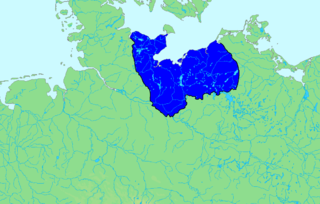
The Obotrites or Obodrites, also spelled Abodrites, were a confederation of medieval West Slavic tribes within the territory of modern Mecklenburg and Holstein in northern Germany. For decades, they were allies of Charlemagne in his wars against the Germanic Saxons and the Slavic Veleti. The Obotrites under Prince Thrasco defeated the Saxons in the Battle of Bornhöved (798). The still-Pagan Saxons were dispersed by the emperor, and the part of their former land in Holstein north of Elbe was awarded to the Obotrites in 804, as a reward for their victory. This however was soon reverted through an invasion of the Danes. The Obotrite regnal style was abolished in 1167, when Pribislav was restored to power by Duke Henry the Lion, as Prince of Mecklenburg, thereby founding the Germanized House of Mecklenburg.
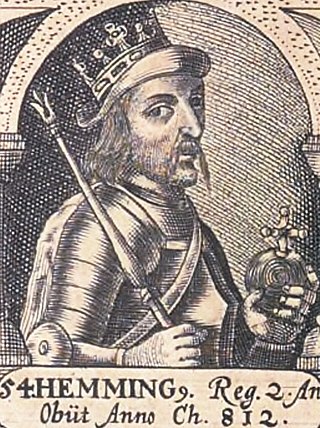
Hemming I was a king in Denmark from 810 until his death. He was the successor of King Gudfred, his uncle.

Polabian Slavs, also known as Elbe Slavs and more broadly as Wends, is a collective term applied to a number of Lechitic tribes who lived scattered along the Elbe river in what is today eastern Germany. The approximate territory stretched from the Baltic Sea in the north, the Saale and the Limes Saxoniae in the west, the Ore Mountains and the Western Sudetes in the south, and Poland in the east.

The Royal Frankish Annals, also called the Annales Laurissenses maiores, are a series of annals composed in Latin in the Carolingian Francia, recording year-by-year the state of the monarchy from 741 to 829. Their authorship is unknown, though Wilhelm von Giesebrecht suggested that Arno of Salzburg was the author of an early section surviving in the copy at Lorsch Abbey. The Annals are believed to have been composed in successive sections by different authors, and then compiled.

The Saxon Wars were the campaigns and insurrections of the thirty-three years from 772, when Charlemagne first entered Saxony with the intent to conquer, to 804, when the last rebellion of tribesmen was defeated. In all, 18 campaigns were fought, primarily in what is now northern Germany. They resulted in the incorporation of Saxony into the Frankish realm and their forcible conversion from Germanic paganism to Christianity.

The Limes Saxoniae, also known as the Limes Saxonicus or Sachsenwall, was an unfortified limes or border between the Saxons and the Slavic Obotrites, established about 810 in present-day Schleswig-Holstein.
Thrasco was the Prince (knyaz) of the Obotrite confederation from 795 until his death in 810. He succeeded his father, Witzlaus II, who had been ambushed and killed by the revolting Saxons. Thrasco defeated the Saxons in the battle on Schwentine River in 798. He was murdered in Reric in 810. Thrasco had a son, Cedragus, the Obotrite prince from 819 to 826.

Sigfred was an eighth century Danish king who is known to have reigned from before 777 to after 798. Fragments of his reign can be traced via Frankish sources.
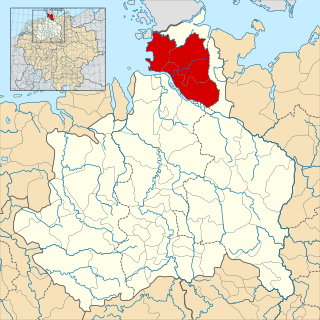
Nordalbingia was one of the four administrative regions of the medieval Duchy of Saxony, the others being Angria, Eastphalia, and Westphalia. The region's name is based on the Latin name Alba for the Elbe River and refers to an area predominantly located north of the Lower Elbe, roughly corresponding with the present-day Holstein region. Situated in what is now Northern Germany, this is the earliest known dominion of the Saxons.
Henry was an Obotrite prince or king (1093–1127) from the Nakonid dynasty; he was regarded by contemporaries as "King of the Slavs". The Obotrite realm reached its greatest area during Henry's rule, extending from the Elbe to the Oder and from the Havelland to the Baltic Sea.
The Drevani were a tribe of Polabian Slavs settling on the Elbe river in the area of the present-day Lüchow-Dannenberg district of Lower Saxony, Germany.
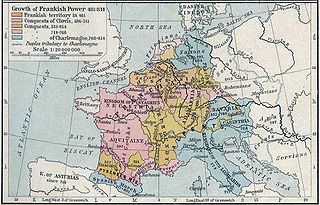
The siege of Trsat was a battle fought over possession of the town of Trsat in Liburnia, near the Croatian–Frankish border. The battle was fought in the autumn of 799 between the defending forces of Dalmatian Croatia under the leadership of Croatian duke Višeslav, and the invading Frankish army of the Carolingian Empire led by Eric of Friuli. The battle was a Croatian victory, and the Frankish commander Eric was killed during the siege.

The Battle of Süntel was a land battle that took place between Saxon rebels led by Widukind and a detachment of Frankish forces led by envoys of Charlemagne named Adalgis, Geilo, and Worad at Süntel in 782 during the Saxon Wars. The result was a victory for the Saxons, resulting in the deaths of Adalgis, Geilo, four counts, and 20 other noblemen. Shortly following the loss, Charlemagne had 4,500 rebels beheaded on a single day, in an event sometimes known as the Verden Massacre.
Praedenecenti was an early medieval Slavic tribe, mentioned only in the Royal Frankish Annals in 822 and 824. They lived in the buffer zone between the Carolingian and Bulgarian empires. The Royal Frankish Annals associated them with the Abodriti, while modern scholars have also connected them to other Slavic tribes, especially the Braničevci or Merehani. The Praedenecenti sought assistance from the Franks against the Bulgars, but they obviously lost their independence because they were not mentioned after 824.
Lüne was a location on the left bank of the lower Elbe, known in connection with the Saxon war of 795. It was a village near Lüneburg.

The terms Danish March and March of Schleswig are used to refer to a territory in modern-day Schleswig-Holstein north of the Eider and south of the Danevirke. It was established in the early Middle Ages as a March of the Frankish Empire to defend against the Danes. The term "Danish March" is a modern designation not found in mediaeval sources. According to the Royal Frankish Annals, the Danish King led his troops "into the March" in 828. In the 852 Yearbook of Fulda, there is mention of a "Guardian of the Danish Border".
The Linones were a small Slavic people first recorded in the early 9th century. They lived north and east of the Elbe, across from Höhbeck in the region around Lenzen, south of the Wilzi and Obotrites, north of the Hevelli and northeast of the Saxons. They may have been a sub-group of the Wilzi and were often under Obotrite control. They may be associated with the medieval Gau Liezizi.
The Bethenici were a West Slavic people living east of the Elbe river in the ninth century. They lived near the confluence of the Elbe and the Havel, probably between the rivers alongside the Smeldingi.
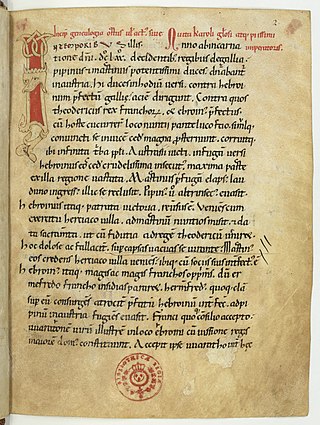
The Chronicle of Aniane is an anonymous Latin history covering the rise of the Carolingian family from 670 to 840. It was composed by a monk of the Abbey of Aniane.